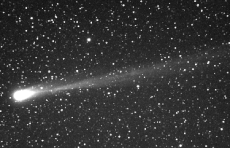Portal:Outer space/Featured/Article/8

Comet Hyakutake (Japanese: 百武彗星 Hyakutake suisei, IPA [çakɯtake sɯiseː]; formally designated C/1996 B2) is a comet that was discovered in January 1996, and passed very close to the Earth in March of that year. It was dubbed The Great Comet of 1996, and was one of the closest cometary approaches to the Earth in the previous 200 years, resulting in the comet appearing very bright in the night sky and being seen by a large number of people around the world. The comet temporarily upstaged the long-awaited Comet Hale–Bopp, which was approaching the inner Solar System at the time, although Hyakutake was at its brightest for only a few days.
Scientific observations of the comet led to several notable discoveries. Most surprising to cometary scientists was the discovery of X-ray emission from the comet, the first time a comet had been found to be emitting X-rays. This emission is believed to be caused by ionised solar wind particles interacting with neutral atoms in the coma of the comet. The Ulysses spacecraft also unexpectedly crossed the comet's tail at a distance of more than 500 million km from the nucleus, showing that Hyakutake had the longest tail yet known for a comet.
Hyakutake is a long-period comet. Before its most recent passage through the Solar System, its orbital period was about 15,000 years, but the gravitational influence of the giant planets has now increased this to 72,000 years.
